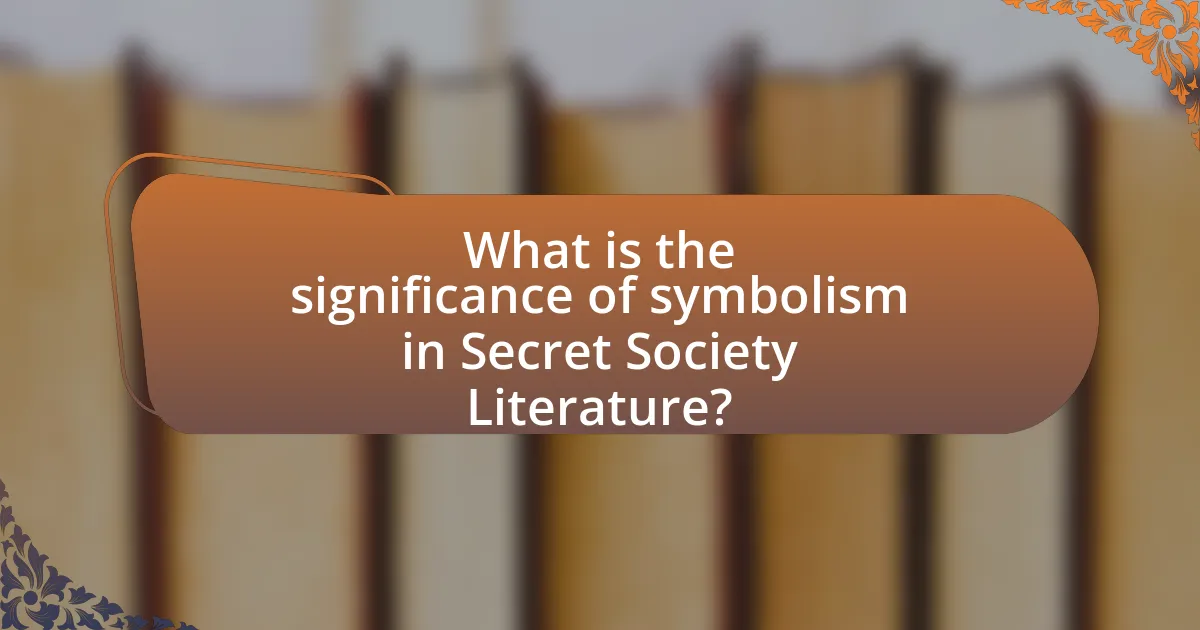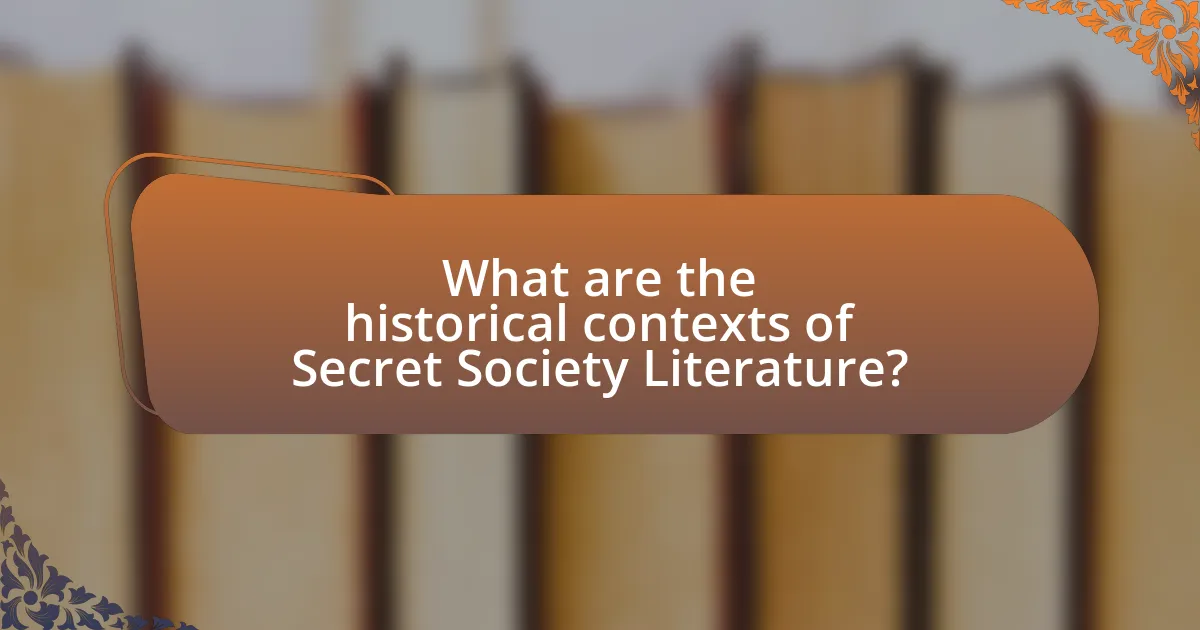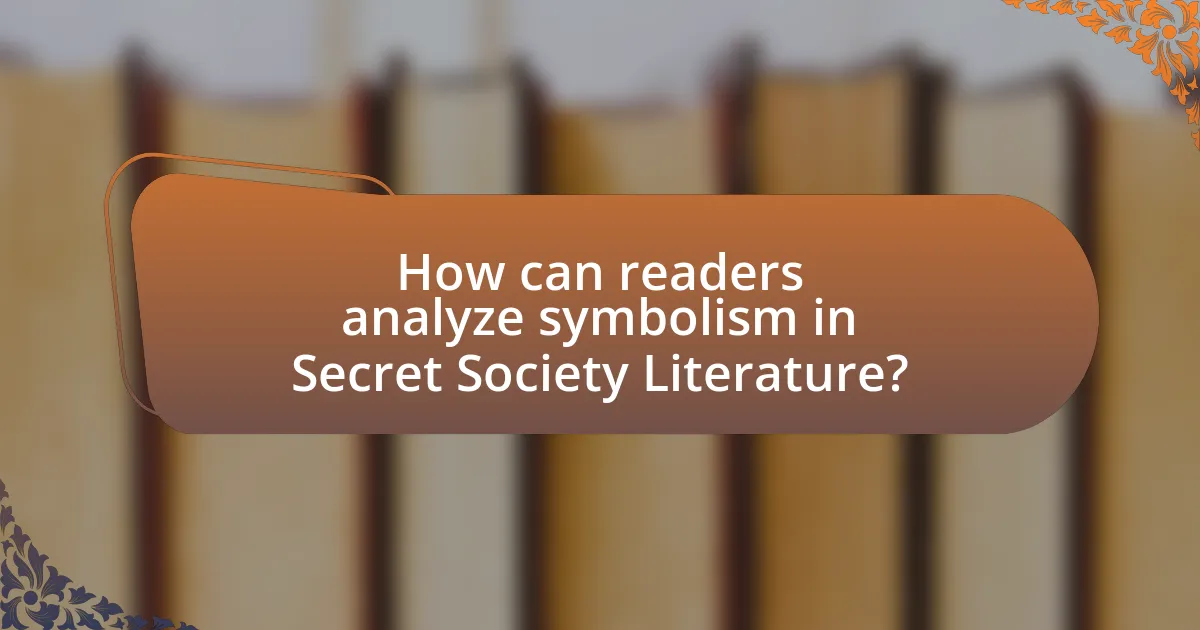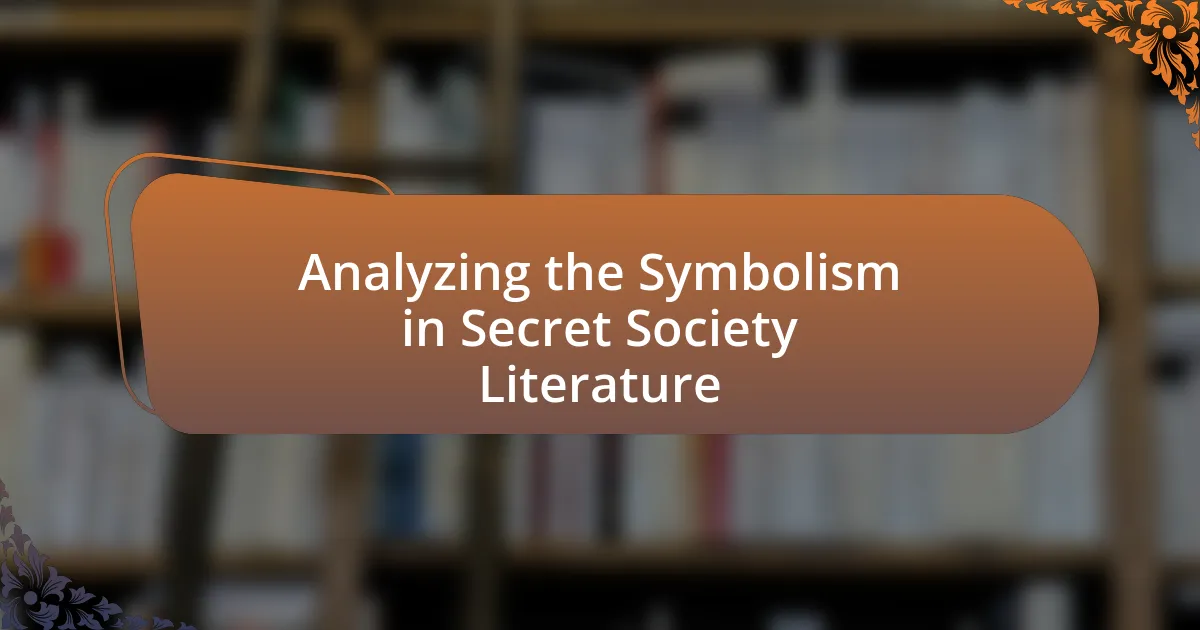The article focuses on the significance of symbolism in Secret Society Literature, highlighting how symbols convey complex ideas and beliefs that are often concealed from outsiders. It explores how symbolism enhances narratives by adding layers of meaning related to themes of secrecy, power, and identity, while also contributing to character development. Common symbols such as the all-seeing eye, keys, and geometric shapes are examined for their roles in representing hidden knowledge and societal dynamics. Additionally, the article discusses the historical contexts of secret societies, their influence on literature, and the cultural factors that shape the interpretation of symbols, providing readers with analytical techniques to deepen their understanding of these texts.

What is the significance of symbolism in Secret Society Literature?
Symbolism in Secret Society Literature is significant because it serves as a means of conveying complex ideas, beliefs, and values that are often hidden from the uninitiated. This literature frequently employs symbols to represent esoteric knowledge, power dynamics, and the quest for enlightenment, allowing members to communicate intricate concepts without revealing them to outsiders. For instance, the use of the all-seeing eye in various secret societies symbolizes vigilance and the pursuit of truth, reflecting the society’s core principles. Such symbols create a shared language among members, reinforcing group identity and solidarity while simultaneously maintaining secrecy.
How does symbolism enhance the narrative in Secret Society Literature?
Symbolism enhances the narrative in Secret Society Literature by providing deeper layers of meaning that reflect the themes of secrecy, power, and identity. For instance, symbols such as keys, masks, and rituals often represent the hidden knowledge and exclusivity associated with secret societies. These symbols create a rich tapestry that allows readers to engage with the text on multiple levels, revealing insights into the characters’ motivations and the societal implications of their actions. The use of symbolism also facilitates the exploration of complex ideas, such as the duality of human nature and the conflict between individual desires and collective goals, which are prevalent in works like “The Da Vinci Code” by Dan Brown, where symbols drive the plot and character development.
What are the common symbols found in Secret Society Literature?
Common symbols found in Secret Society Literature include the all-seeing eye, the pyramid, and various geometric shapes such as the square and compass. The all-seeing eye, often depicted within a triangle, represents divine providence and the idea of surveillance by a higher power. The pyramid symbolizes strength and the journey towards enlightenment, often associated with the concept of ascension in many secret societies. Geometric shapes like the square and compass are frequently used in Freemasonry, representing morality and the importance of balance in life. These symbols serve as tools for conveying complex philosophical ideas and fostering a sense of identity among members.
How do these symbols contribute to character development?
Symbols in secret society literature significantly contribute to character development by embodying the internal conflicts and transformations of characters. For instance, a character’s association with a specific symbol, such as a key or a mask, often reflects their journey towards self-discovery or their struggle with identity. This is evident in works like “The Da Vinci Code,” where the symbol of the key represents both knowledge and the burden of truth, influencing the protagonist’s decisions and moral dilemmas. Such symbols serve as catalysts for character growth, revealing deeper motivations and facilitating pivotal moments in the narrative.
Why do authors use secret societies as a motif?
Authors use secret societies as a motif to explore themes of power, secrecy, and the human condition. This motif allows writers to delve into the complexities of social hierarchies and the influence of hidden agendas on individual lives. For instance, in works like Dan Brown’s “The Da Vinci Code,” the secret society serves as a vehicle to examine historical truths and the conflict between knowledge and ignorance. The use of secret societies often reflects real-world organizations, such as the Freemasons, which have historically been shrouded in mystery, thereby enhancing the narrative’s intrigue and depth.
What themes are often explored through secret societies?
Secret societies often explore themes of secrecy, power, knowledge, and initiation. These themes reflect the hidden nature of such organizations, where secrecy serves to create an exclusive environment that fosters a sense of power among members. Knowledge is a central theme, as many secret societies claim to possess esoteric wisdom that is accessible only to initiates, reinforcing the idea of enlightenment through initiation rituals. Historical examples include the Freemasons, who emphasize moral and ethical teachings, and the Illuminati, which is often associated with conspiracy theories surrounding control and influence in society. These themes are prevalent in literature and cultural discussions surrounding secret societies, illustrating their complex role in societal dynamics.
How do secret societies reflect societal issues?
Secret societies reflect societal issues by embodying the values, fears, and aspirations of their time. For instance, during periods of political unrest, such as the Enlightenment, groups like the Freemasons emerged, promoting ideals of liberty and fraternity in response to authoritarianism. Additionally, secret societies often serve as a critique of social hierarchies, as seen in the formation of groups like the Illuminati, which sought to challenge the established order and promote rational thought. Historical evidence shows that these organizations frequently arise in response to perceived injustices, such as economic inequality or lack of representation, highlighting the societal tensions that drive their formation and activities.

What are the historical contexts of Secret Society Literature?
Secret Society Literature has historical contexts rooted in the Enlightenment, the rise of Freemasonry in the 18th century, and the socio-political upheavals of the 19th and 20th centuries. During the Enlightenment, intellectuals began to explore themes of secrecy, knowledge, and power, which influenced the formation of secret societies that often sought to challenge established norms. Freemasonry, which emerged prominently in the early 1700s, utilized symbols and allegories to convey moral and philosophical teachings, thus laying the groundwork for later literary explorations of secrecy and initiation. Additionally, the tumultuous political landscapes, such as revolutions and wars, prompted writers to reflect on the clandestine operations of groups like the Illuminati and other secret organizations, further embedding these themes in literature. This interplay of historical events and secretive organizations has shaped the narrative and symbolic frameworks found in Secret Society Literature.
How have historical secret societies influenced literature?
Historical secret societies have significantly influenced literature by providing rich symbolism, themes of secrecy, and complex narratives that explore power dynamics and human nature. For instance, the Freemasons, known for their rituals and allegorical teachings, have inspired numerous works, including Dan Brown’s “The Da Vinci Code,” which intertwines historical facts with fictional elements related to Masonic lore. Additionally, the Rosicrucians, with their mystical philosophies, have shaped literary movements such as Romanticism, where authors like Goethe incorporated esoteric ideas into their writings. These societies often serve as metaphors for hidden knowledge and societal critique, allowing authors to explore deeper philosophical questions and societal structures.
What are some notable secret societies that appear in literature?
Notable secret societies that appear in literature include the Illuminati, Freemasons, and the Knights Templar. The Illuminati, often depicted in works like Dan Brown’s “Angels & Demons,” symbolizes the quest for knowledge and power, reflecting societal fears of hidden influence. The Freemasons, featured in various novels such as “The Da Vinci Code,” represent themes of brotherhood and secrecy, often associated with moral and ethical dilemmas. The Knights Templar, prominent in historical fiction like “The Templar Legacy” by Steve Berry, embody the clash between faith and ambition, illustrating the complexities of loyalty and betrayal. These societies serve as powerful symbols, enriching narratives with layers of intrigue and moral questioning.
How do historical events shape the portrayal of secret societies in literature?
Historical events significantly shape the portrayal of secret societies in literature by influencing the themes, motivations, and societal perceptions depicted in narratives. For instance, the Enlightenment period, marked by a surge in intellectual thought and skepticism towards authority, led to the romanticization of secret societies like the Freemasons in works such as Dan Brown’s “The Da Vinci Code,” where they are portrayed as guardians of ancient knowledge. Additionally, the political upheaval during the French Revolution prompted authors to depict secret societies as subversive forces challenging oppressive regimes, as seen in Victor Hugo’s “Les Misérables.” These portrayals reflect the societal anxieties and aspirations of their respective historical contexts, illustrating how literature serves as a mirror to the complexities of secret societies shaped by the events of their time.
What role does culture play in the symbolism of Secret Society Literature?
Culture plays a crucial role in the symbolism of Secret Society Literature by shaping the values, beliefs, and practices that inform the narratives and symbols used within these texts. For instance, the use of specific symbols, such as the owl in Freemasonry, reflects cultural associations with wisdom and knowledge, which are significant in various societies. Additionally, cultural contexts influence the interpretation of rituals and allegories found in secret society literature, as seen in works like “The Da Vinci Code” by Dan Brown, where historical and cultural references enhance the depth of the symbolism. This interplay between culture and symbolism allows readers to engage with the literature on multiple levels, revealing insights into societal norms and collective consciousness.
How do cultural differences affect the interpretation of symbols?
Cultural differences significantly influence the interpretation of symbols, as symbols often carry distinct meanings shaped by cultural contexts. For instance, the color white symbolizes purity in Western cultures, while in some Eastern cultures, it represents mourning. This divergence illustrates how cultural backgrounds can lead to varied understandings of the same symbol. Additionally, research by Geert Hofstede highlights that cultural dimensions, such as individualism versus collectivism, affect how symbols are perceived and utilized within different societies. Thus, the interpretation of symbols is not universal but rather deeply rooted in cultural narratives and values.
What are examples of culturally specific symbols in this genre?
Examples of culturally specific symbols in secret society literature include the Freemason square and compass, which represents morality and the importance of balance in life. Additionally, the Ouroboros, a symbol of a serpent eating its own tail, signifies the cyclical nature of life and rebirth, often found in various esoteric traditions. The Ankh, an ancient Egyptian symbol representing life and immortality, also appears in secret society contexts, emphasizing the quest for eternal knowledge. These symbols are deeply rooted in their respective cultures and convey complex meanings related to secrecy, knowledge, and the human experience.

How can readers analyze symbolism in Secret Society Literature?
Readers can analyze symbolism in Secret Society Literature by identifying recurring motifs, themes, and imagery that represent deeper meanings related to secrecy, power, and knowledge. This analysis involves examining specific symbols, such as rituals, objects, or characters, that convey the hidden agendas or philosophies of the societies depicted. For instance, the use of masks in literature often symbolizes the concealment of identity and intentions, reflecting the duality of public versus private personas within secretive organizations. By contextualizing these symbols within the narrative and considering historical or cultural references, readers can uncover the layers of meaning that enrich their understanding of the text.
What techniques can be used to identify symbols in texts?
Techniques to identify symbols in texts include close reading, contextual analysis, and intertextual comparison. Close reading involves examining the text meticulously to uncover recurring motifs or imagery that may signify deeper meanings. Contextual analysis requires understanding the historical, cultural, and social background of the text, which can reveal how symbols function within that framework. Intertextual comparison involves analyzing how symbols are used across different texts, allowing for a broader understanding of their significance. These methods are supported by literary theory, which emphasizes the importance of context and textual relationships in interpreting symbols.
How can context enhance the understanding of symbols?
Context enhances the understanding of symbols by providing the necessary background and situational factors that shape their meanings. In secret society literature, symbols often carry layered meanings that are influenced by historical, cultural, and social contexts. For example, the use of the owl as a symbol in various secret societies can represent wisdom, but its interpretation may vary depending on the specific society’s beliefs and the era in which it operates. Historical evidence shows that the owl was associated with Athena in ancient Greece, symbolizing knowledge and strategy, which informs its use in modern contexts. Thus, understanding the context allows for a more nuanced interpretation of symbols, revealing deeper insights into the values and intentions of the societies that employ them.
What are some common pitfalls in interpreting symbolism?
Common pitfalls in interpreting symbolism include overgeneralization, where interpreters apply a single meaning to symbols without considering context, and personal bias, which can lead to subjective interpretations that stray from the intended message. Additionally, ignoring historical and cultural contexts can result in misinterpretations, as symbols often carry specific meanings within particular societies or time periods. For instance, the use of the owl in various cultures symbolizes wisdom, but in some secret societies, it may represent secrecy or the unknown. Misunderstanding the creator’s intent can also lead to flawed interpretations, as symbols may have been designed to convey complex ideas that require nuanced understanding.
What resources are available for deeper analysis of symbolism?
Resources available for deeper analysis of symbolism include academic journals, books, and online databases. Scholarly articles in journals such as “Symbolism: An International Journal of Critical Theory” provide peer-reviewed insights into various symbolic interpretations. Books like “The Symbolism of Freemasonry” by Albert G. Mackey and “The Secret Teachings of All Ages” by Manly P. Hall offer extensive explorations of symbolism within secret societies. Additionally, databases like JSTOR and Project MUSE contain a wealth of research articles and essays focused on symbolism in literature and culture, facilitating comprehensive analysis.
Which literary criticism approaches are most effective for this analysis?
The most effective literary criticism approaches for analyzing symbolism in secret society literature are psychoanalytic criticism and sociocultural criticism. Psychoanalytic criticism allows for the exploration of the unconscious motivations and desires of characters, revealing deeper meanings behind symbols associated with secret societies. For instance, Freud’s theories on repression and the unconscious can illuminate how symbols reflect societal fears or desires related to secrecy and power. Sociocultural criticism, on the other hand, examines the cultural and historical contexts in which these texts are produced, providing insights into how symbols function within specific societal frameworks. This approach can highlight how secret societies symbolize broader themes of authority, exclusion, and identity within a given culture. Together, these approaches offer a comprehensive framework for understanding the multifaceted symbolism present in secret society literature.
How can readers apply these analytical techniques to their own reading?
Readers can apply analytical techniques to their own reading by actively identifying and interpreting symbols within the text. For instance, when engaging with secret society literature, readers should look for recurring motifs, such as specific colors, objects, or phrases that may represent broader themes like power or secrecy. This method allows readers to uncover deeper meanings and connections that enhance their understanding of the narrative. Research indicates that analyzing symbolism can lead to improved comprehension and retention of literary works, as it encourages critical thinking and personal engagement with the material.
